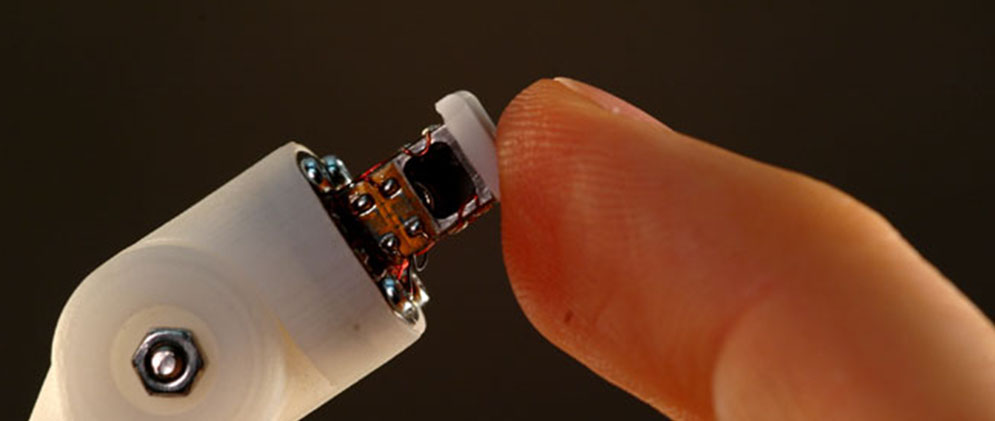Haptic Tether for Human Robot Communication
From The Theme
SMART OFFICE WORKFLOWS
WHAT IF
What if we could help mobile robots navigate crowded environments using haptic communication?
WHAT WE SET OUT TO DO
We set out to explore the use of haptic communication to improve human-mobile robot interaction, especially in crowded environments, such as offices and shopping malls.
We developed and tested a “tether system” – a wearable haptic interface that enables the robot to communicate intent to the user via silent, private, bidirectional vibration patterns.
To test the system, the user and the robot were put on intersecting paths, so that either the human or the robot had to yield the right of way to avoid collision. Under certain conditions, the robot’s intent (to yield to the human or not) was revealed to the human via the haptic interface. Data from this user study was analyzed to develop a model to predict users’ trajectories.
WHAT WE FOUND
Research results showed that haptic communication between users and mobile robots affects the user’s choice of navigation strategies. Haptic communication shifted two key parameters of the predictive model – the user’s “safety buffer” radius and the user’s expectation of the robot’s future velocity. Our model successfully predicted users’ behavior 87% of the time. In addition, tests of existing asymmetric vibration haptic devices found that they need improvement to provide sufficient directional cues during human walking and high cognitive load.
LEARN MORE
Y. Che, C. T. Sun, and A. M. Okamura, “Avoiding Human-Robot Collisions using Haptic Communication”, submitted to Robotics and Automation Letters, 2018.
Y. Che, H. Culbertson, C.-W. Tang, S. Aich, and A. M. Okamura, “Design and Evaluation of a Virtual Tether for Mobile Robot-Human Interaction”, submitted to IEEE Transactions on Human-Machine Systems, 2017. (in review)
Presentation:
Y. Che and A. M. Okamura, “Haptic Communication for Human-Mobile Robot Interaction”, will be presented at Workshop on Assistance and Service Robots in a Human Environment, IEEE/RSJ International Conference on Intelligent Robots and Systems on September 28, 2017.
PEOPLE BEHIND THE PROJECT
 Allison Okamura is a Professor in the Mechanical Engineering department at Stanford University, with a courtesy appointment in computer science. She was previously Professor and Vice Chair of Mechanical Engineering at Johns Hopkins University. Her academic interests include haptics, teleoperation, virtual environments and simulators, medical robotics, neuromechanics and rehabilitation, prosthetics, and engineering education. She has been an associate editor of the IEEE Transactions on Haptics, an editor of the IEEE International Conference on Robotics and Automation Conference Editorial Board, and co-chair of the IEEE Haptics Symposium.
Allison Okamura is a Professor in the Mechanical Engineering department at Stanford University, with a courtesy appointment in computer science. She was previously Professor and Vice Chair of Mechanical Engineering at Johns Hopkins University. Her academic interests include haptics, teleoperation, virtual environments and simulators, medical robotics, neuromechanics and rehabilitation, prosthetics, and engineering education. She has been an associate editor of the IEEE Transactions on Haptics, an editor of the IEEE International Conference on Robotics and Automation Conference Editorial Board, and co-chair of the IEEE Haptics Symposium.
 Yuhang Che received a B.S. degree from Shanghai Jiaotong University, Shanghai, China, and Purdue University, West Lafayette, IN, USA, and an M.S. degree from Stanford University, Stanford, CA, USA, all in Mechanical Engineering. He is currently working toward the Doctoral degree in Mechanical Engineering with Stanford University. His research interests include human robot interaction, autonomous robot, robot perception and sensing, teleoperation and haptics.
Yuhang Che received a B.S. degree from Shanghai Jiaotong University, Shanghai, China, and Purdue University, West Lafayette, IN, USA, and an M.S. degree from Stanford University, Stanford, CA, USA, all in Mechanical Engineering. He is currently working toward the Doctoral degree in Mechanical Engineering with Stanford University. His research interests include human robot interaction, autonomous robot, robot perception and sensing, teleoperation and haptics.
